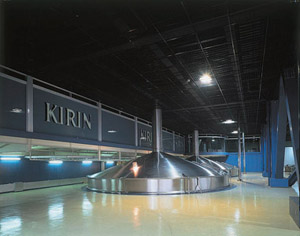The Kirin Beer Story
|
Kirin Beer, it seems, is doing everything right these days. Domestically, their products have always had visibility, especially with celebrities like Suzuki Ichirô gracing its commercials. But now Kirin is branching out from its more traditional offerings. As micro-brewing continues to take off in Japan—possibly threatening the market share of all major brewers—Kirin is actively catering to niche tastes with similar offerings. The company has released several premium beers, including a Belgian white. Their new stout (which replaced the Gargary Stout made in collaboration with Echigo Beer last year) is rivaling Guinness as one of the most readily available dark beers in Japan. Overseas, Kirin has been no slouch either. Ichiban Shibori, Kirin’s mainstay beer, is being produced in the U.S. market by AB and in the U.K. by Wells and Young. The company has also worked out domestic distribution deals with Hoegaarden, Stella Artois and even Guinness, which previously had a contract with Sapporo. Most impressive, perhaps, has been Kirin’s acquisitions and tie-ups. It recently purchased San Miguel in the Philippines and, before that, Lion Nathan in Australia. No doubt we will hear of further expansion down the road as Kirin reaches into the Chinese market. So by what glorious means came Kirin to such eminence? Like many great things, its origins are humble and involve an entrepreneur. In 1870, William Copeland, an American, established the Spring Valley Brewery in Yamate, Yokohama. He mainly imported his raw ingredients from San Francisco and brewed in barrels. Foreign management of the company continued as it expanded, and the Yamate brewery property inherited from Copeland by a resident proprietor was eventually established as the Japan Brewery. In 1888, they released Kirin lager beer and their fortunes took off. The official founding of the Kirin Brewery Company, Ltd. came in 1907. Little remains of that little brewery up on Yamate—just a preserved stone well. The Great Kanto Earthquake of 1923 destroyed mostly everything. Kirin reestablished the brewery up the coast, in Tsurumi-ku, and today it is a sprawling complex with about a dozen like it across the country—the Fukuoka brewery, in fact, is three times as large! Even if you don’t care much for beer, a visit to one of the factories will likely be a fascinating experience. The guided tour at the Kirin Yokohama Beer Village was state of the art, with video screens showing each step of the process in clear detail. Along many parts of the tour, you can of course watch some of the activity through large glass windows. At the end, you can do some tasting. The guides are knowledgeable—as they should be—but even beer geeks won’t be disappointed (I deliberately asked a few obscure questions). Perhaps the bottling, canning and “kegging” process was the most interesting. The contrast between the massive machinery and the precision of its tiny, intricate parts is hard to fathom, even when you see it. Perhaps we all forget that a good, mainstream beer is not simply the result of decades or even centuries of recipe refinement. Cutting edge manufacturing and robotic science, extensive laboratory research on ingredients such as yeast, and of course devoted barley and hops agriculture all contribute to the making of a good Kirin brew. But what contributes to the making of a good company? As Kirin looks to capitalize on world markets, it hasn’t forgotten the world itself. Parts of the tour show Kirin’s commitment to the environment. While cynics may point out that there are very real economic incentives for going green, it seems obvious that the company is committed to the good cause. As some examples, Kirin is ambitious in reducing its carbon footprint. The water used in the Tsurumi plant is sourced locally, from nearby Sagami Lake, reducing the energy required to transport it. Kirin has surpassed its own goals and reduced its CO2 output by 26% since 1990. They are working toward further cuts. Nearly 100% of its returnable bottles are recycled. Innovative can design has reduced aluminum consumption by 26,000 tons each year. Some of the by-products of processing become animal feed. Yum. Kirin is taking CSR (corporate social responsibility) very seriously. Their thick CSR handbook outlines a vast array of activities and commitments that enrich society, from sponsorship of sports and the arts to grants and scholarships. It is unlikely that Kirin will recoup the millions it is investing in community endeavors because thankful citizens will buy more beer. But that’s not the point. The point is a good company, a good beer, and you. Cheers to that. Tours with English support are available. Call for tour reservations. Drink responsibly Ry Beville, a craft-beer enthusiast, has visited breweries across Europe, America & Japan. |
このところキリンビールが元気だ。コマーシャルにもイチローなどの有名人を起用し、商品アピールに成功している。しかしそんな中で今キリンはさらに新しいチャレンジを試みている。各地の地ビールが伸びてきて、時には大手メーカーのシェアを脅かしたりし始めている中で、キリンもマニアックな嗜好に積極的に対応し、すでにベルギー風白ビールなど、いくつかの高級ビールを発売している。新しい黒ビール(昨年、エチゴビールと共同開発したガージェリー・スタウトに代わる新商品として開発された)は、日本で簡単に手に入る黒ビールの一つとして、ギネスに対抗できるおいしいビールに仕上がっている。 海外での動きも活発だ。主力商品である「一番搾り」はアメリカではアンハイザー・ブッシュ社、イギリスではウェルズ&ヤング社との提携により現地で製造・販売している。また、ヒューガルデン、ステラ・アルトワなどのベルギー・ビール、そして最近までサッポロビールが扱っていたギネスについても最近キリンが輸入販売元となった。企業買収、企業提携にも積極的で、オーストラリアのライオン・ネイサン社に続いて最近フィリピンのサン・ミゲール社を傘下に収めた。中国への本格的な進出も遠い将来のことではないだろう。 同社の歴史を見てみよう。多くの大企業がそうであるように、キリンも最初は一人の起業家からスタートした。ノルウェー生まれのアメリカ人、ウィリアム・コープランドは1870年に横浜の山手に土地を購入しスプリング・バレー・ブルワリーを立ち上げてビールを造り始めた。彼は原料を主にサンフランシスコから輸入し、樽でビールの醸造を行っていたが、やがてこの醸造所は同じ場所でジャパン・ブルワリーという新しいビール会社に生まれ変わることになった。そして1888年に初めての「麒麟麦酒」が発売され、1907年に「麒麟麦酒株式会社」が正式に創立された。 現在、山手に残されているのは当時使われていた井戸くらいのものである。1923年の関東大震災によって横浜山手工場はほとんど壊れてしまったため、鶴見区に新工場が建てられた。今では日本全国各地に10を超える工場があり、福岡工場は実に横浜工場の3倍という巨大さだ。各工場は見学ができ、レストランがあったり、いろいろなイベントが企画されていたりして、ビールに興味が無い人でも楽しめるように工夫されているので是非、工場見学に足を運んでみよう。 そこで今回、キリン横浜ビアビレッジのガイド付きツアーに行ってみた。ビデオスクリーンによる迫力ある映像でビール製造の各工程が分かりやすく紹介され、大きなガラスウィンドウ越しに各工程を実際に見ることが出来る。そして最後には出来立てビールの試飲が待っている。ガイドさんは当然ながら知識が豊富で、僕のちょっと意地悪な質問にもバッチリ答えてくれた。専門的な質問にも詳しく答えてくれる。瓶詰め、缶詰め、樽詰めのラインが特に興味深かった。巨大設備とそれを構成する細かなパーツの精密さは実際に目の当たりにしても信じられないほどだった。そして、美味しいビールは単に長年にわたる味の改良の結果生まれるというものではない、ということが分かった。最新の製造技術、酵母菌など原料に関する研究、そしてより良い大麦とホップの栽培、それらのものが全て合わさって初めて美味しいビールが出来上がる。 では、良い会社はどのようにして生まれるのか。キリンビールは海外市場に投資する一方、環境への配慮も忘れていない。キリンビールの環境に対する取り組みは今回の工場見学ツアーでも紹介されていた。経済的動機に基づくものだと皮肉る向きもあるが、同社が真面目に地球環境保全に取り組んでいることは間違いない。例えば鶴見工場で使う水は近隣の相模湖から引いているほか、他の工場も近隣の水源を利用することで二酸化炭素の排出量の削減を実現している。キリンビールは1990年以降、二酸化炭素の排出量を26%削減して目標数値をクリアし、さらなる二酸化炭素排出量の削減に取り組んでいる。また、空き瓶はほぼ100%回収されてリサイクル使用されている。缶の形状も工夫され、アルミニウムの使用量は26000トンも減ったという。ビール製造の過程で生じる副産物は動物の飼料として利用されている。 キリンビールはCSR(企業の社会的責任)活動にとても積極的な企業だ。分厚いCSRハンドブックを見ると、同社が取り組んでいる様々な社会活動が記載されている。スポーツや芸術に対する支援をはじめ、さまざまな奉仕活動を行っている。キリンビールのこうした活動をありがたく思う人たちがビールをたくさん飲んでくれるからといって、キリンビールが社会的奉仕に使ったおカネが回収できるものではないだろう。しかしそれは問題ではない。良い企業とおいしいビール、そして今これを読んでいる読者の皆さんに乾杯しよう。 英語のサポートによる工場見学ツアーも可能とのこと。見学受付係まで問い合わせを。お酒は二十歳を過ぎてから。 www.kirin.co.jp/about/brewery/factory Ry Bevilleは地ビール大好き人間。おいしい地ビールを求めてヨーロッパやアメリカそして日本中を飲み歩いている。 |









